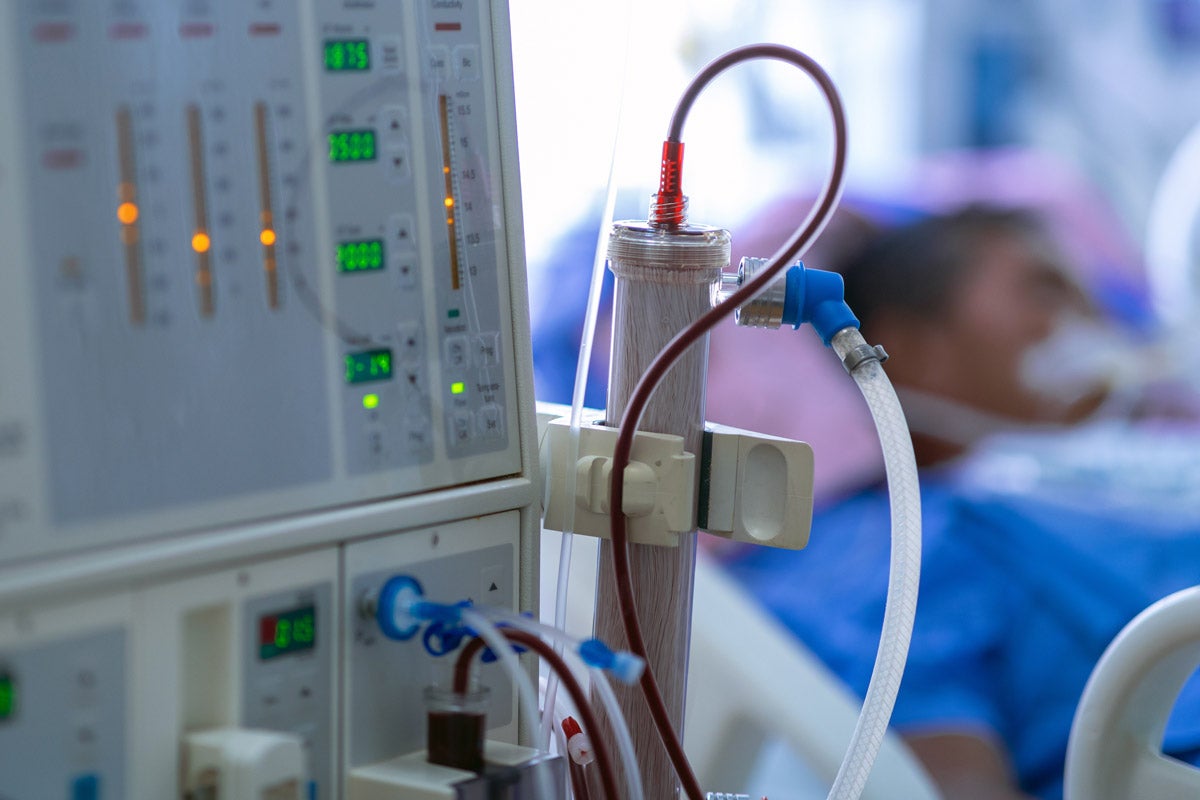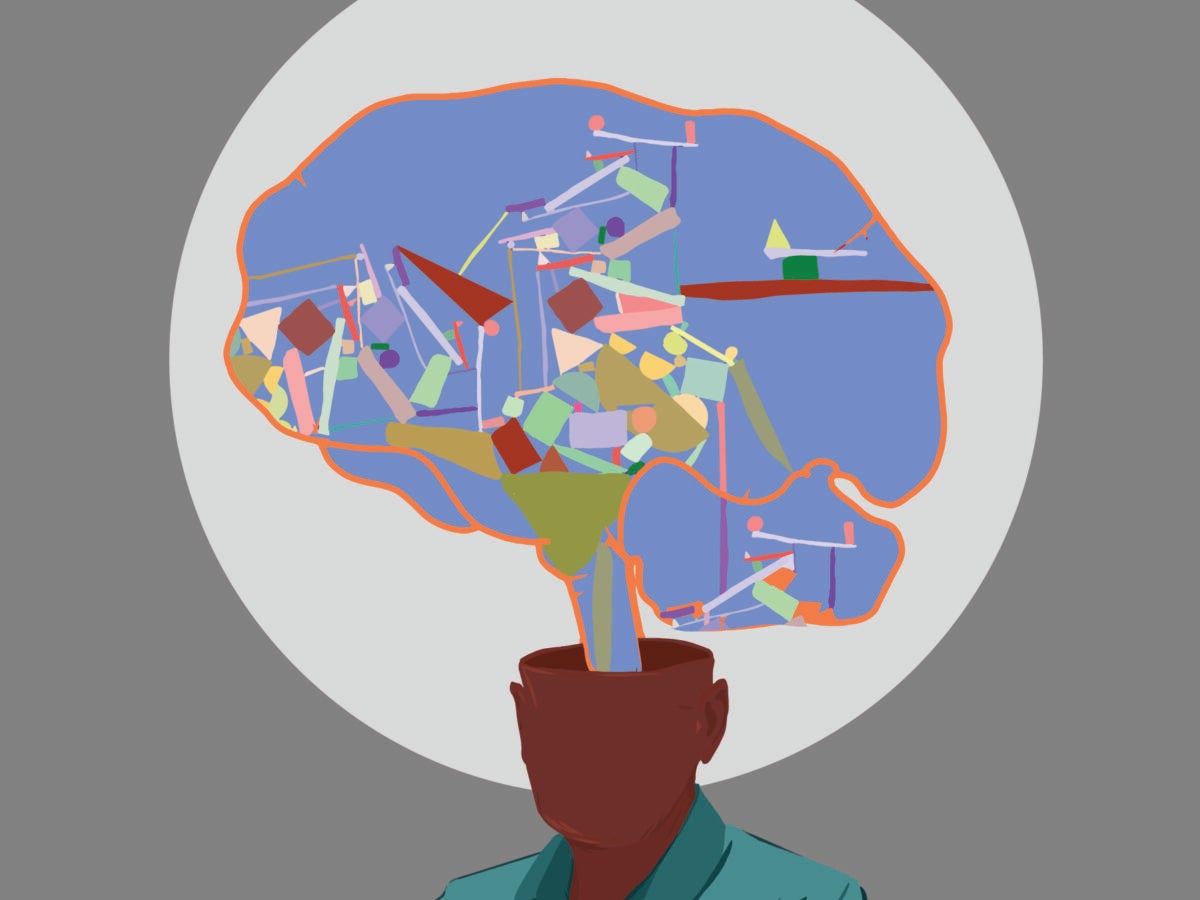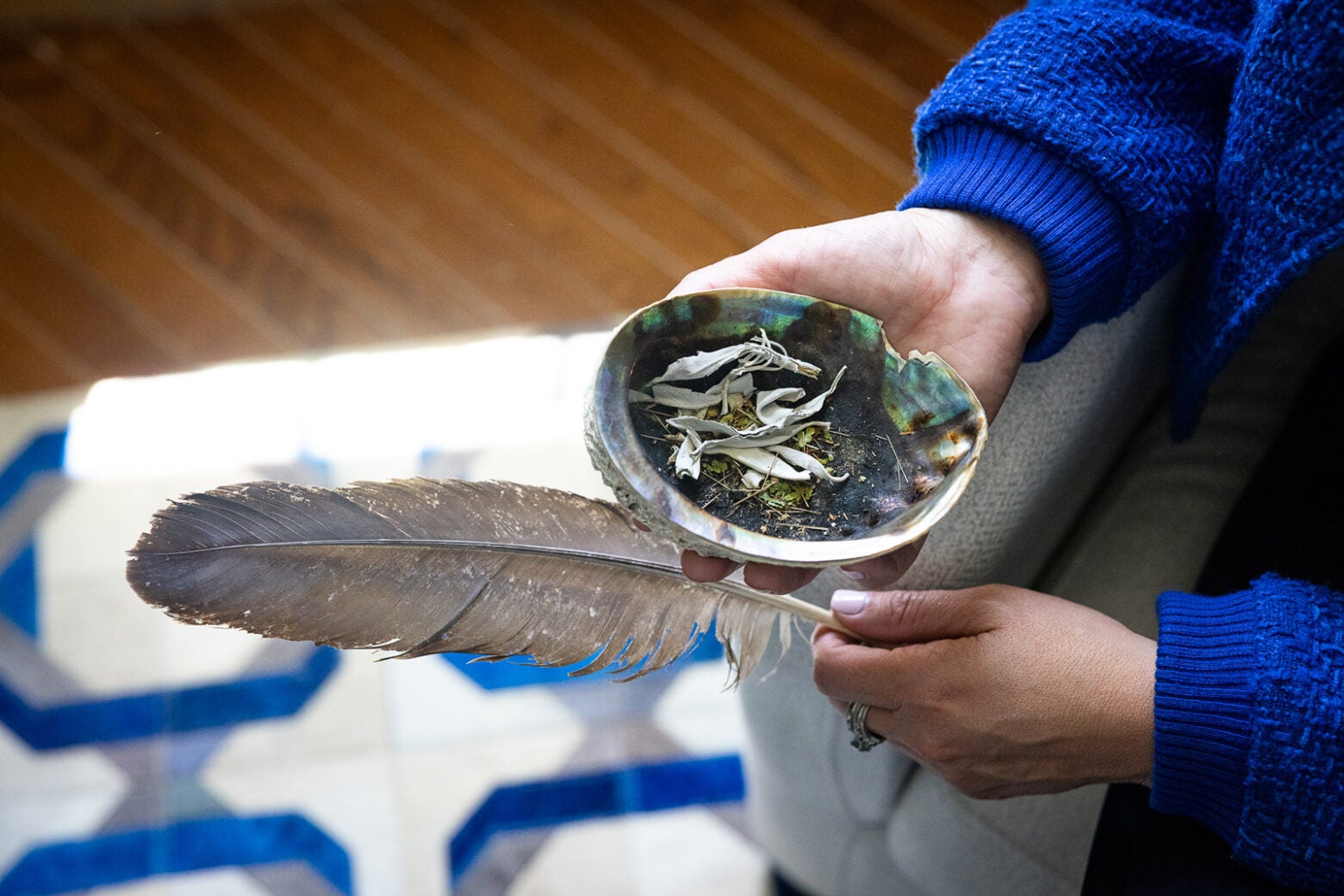
Feature
A Wabanaki organization forges its own approach to addiction treatment
This story was originally published by The Maine Monitor, a nonprofit and nonpartisan news organization. To get regular coverage from the Monitor, sign up for a free Monitor newsletter here.
Entering the Healing Lodge, a log building steps from downtown Millinocket, visitors are greeted by the soft sounds of a flute and the aroma of burnt sage and fresh sweetgrass.
Anchoring the space is a massive stone fireplace. The two-story building is filled with wood paneling, high ceilings, and exposed beams—vestiges of the original owners, the stars of the late-2000s Discovery Channel show American Loggers.
While some aspects remain of what was once a popular bar and restaurant run by the Pelletier family, the nonprofit Wabanaki Public Health and Wellness, which bought the building in 2020, has transformed the space to better suit its new purpose: a community center for Indigenous people recovering from substance use disorder and healing from trauma.
Sign up for Harvard Public Health
Delivered to your inbox weekly.
The Healing Lodge is one of several treatment and recovery facilities run by Wabanaki Public Health and Wellness (WPHW), an organization that works to provide culturally sensitive health care and social services to the four federally recognized tribal nations in Maine: Houlton Band of Maliseet Indians, Mi’kmaq Nation, Penobscot Nation, and the Passamaquoddy Tribe at Motahkomikuk (Indian Township) and Sipayik (Pleasant Point), which collectively form the Wabanaki Nations.
The Wabanaki Nations, like the state of Maine, are entitled to money from landmark settlements with manufacturers, distributors, and retailers accused of “supercharging” the opioid epidemic.
But the $2.9 million that the Wabanaki Nations combined are set to receive across 18 years pales in comparison to the approximately $230 million going to state and local governments in Maine. The tribal opioid settlements were negotiated separately from those with the states.
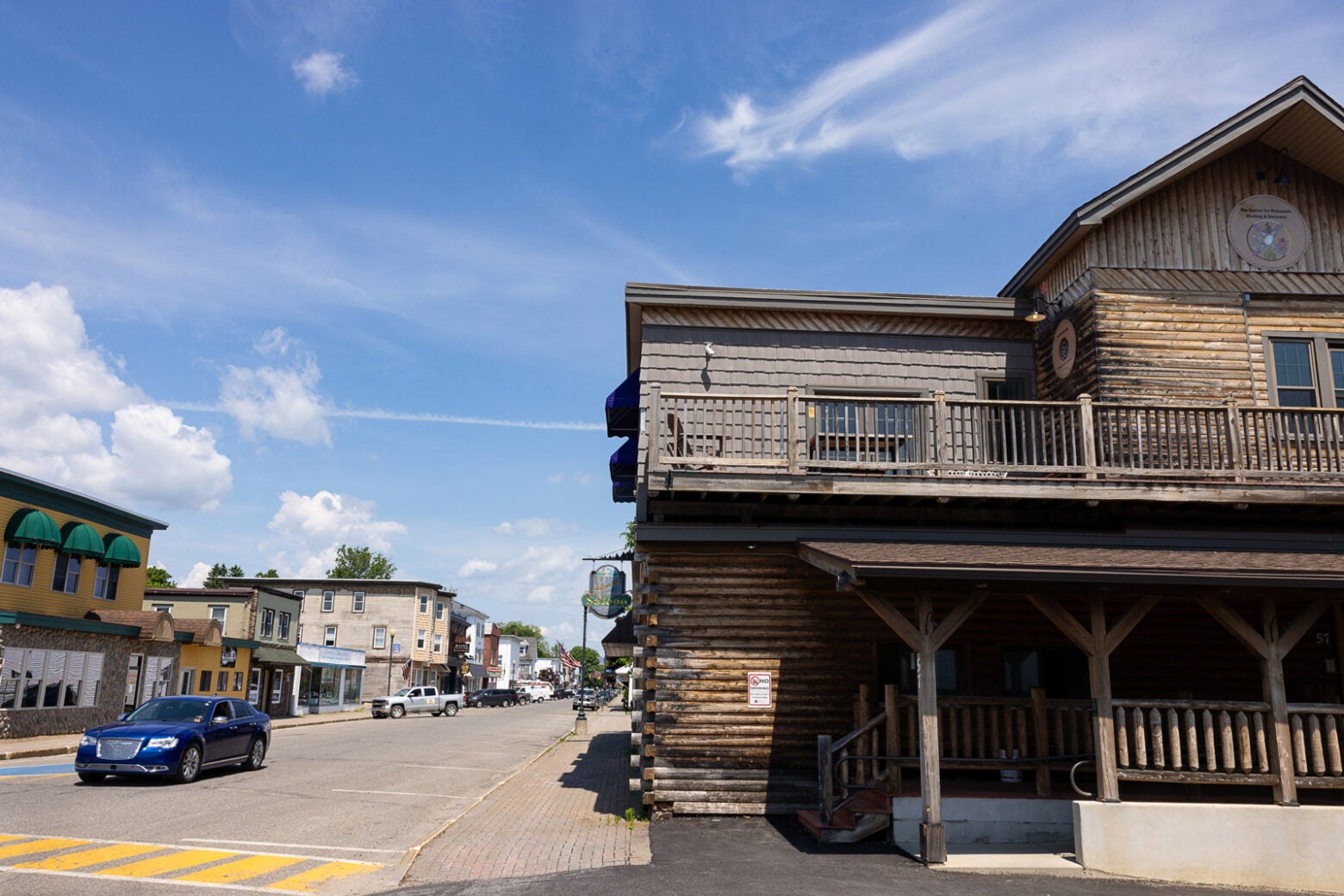
The Healing Lodge, a community and recovery center for Indigenous people, sits at the edge of downtown Millinocket.
Photo: Katherine Emery
This sum is “like a drop in the bucket compared to what [the Wabanaki Nations] have spent, compared to what they anticipate spending,” Corey Hinton told KFF Health News earlier this year. Hinton is a Portland attorney with Drummond Woodsum who represented some of the Wabanaki Nations in litigation, and [he is] a citizen of the Passamaquoddy Tribe at Sipayik.
About 15 years ago, Wabanaki leaders met with public health professionals, including then-director of the state Office of Minority Health Lisa Sockabasin, to discuss how to address substance use in their communities. Sockabasin, a citizen of the Passamaquoddy Tribe at Motahkomikuk, is now the co-CEO of WPHW.
“What we needed was an infrastructure. We needed services. We needed culturally appropriate, culturally centered services that incorporated our language, our history, that full understanding of who Wabanaki people are,” she said.
“We have, as nations, been historically left out of being provided with the health services that we needed,” Sockabasin said.
For years, Wabanaki people who needed treatment for substance use disorder often had no choice but to leave their communities, traveling as far as North Carolina or Florida to get services.
“We are never receiving enough money to even scratch the surface of the problem. There is a lot of work to be done and a lot of trauma to be healed,” Sockabasin said.
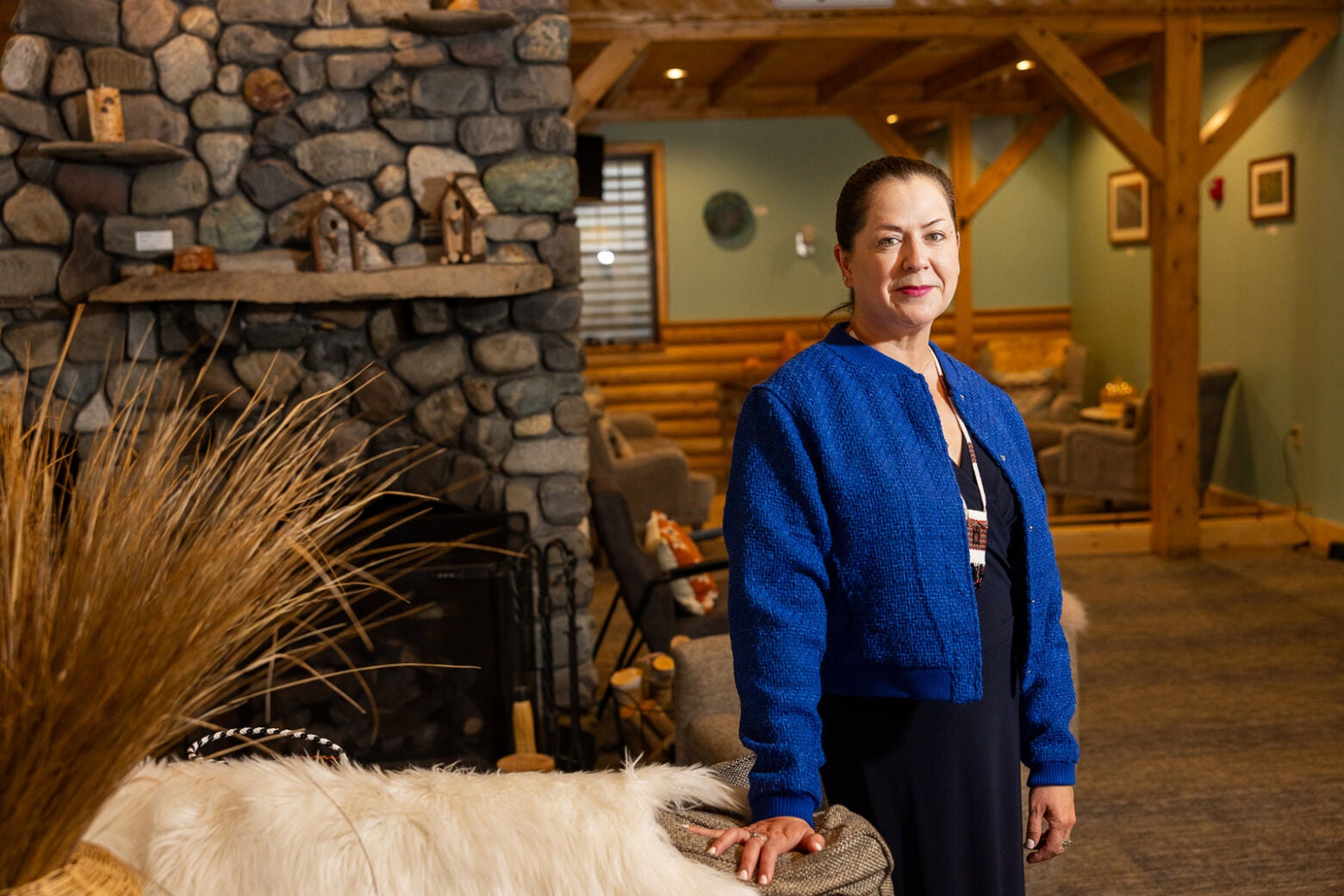
Lisa Sockabasin, the co-CEO of Wabanaki Public Health and Wellness and a citizen of the Passamaquoddy Tribe at Motahkomikuk, at the Healing Lodge in Millinocket
Photo: Katherine Emery
Across the country, communities are making tough decisions about how opioid settlement money should be spent. The Maine Recovery Council, which controls half of the state’s share, has allocated $9 million so far to support various initiatives around the state, from funding for a new recovery center in Piscataquis County to assistance for organizations that serve youth. The council recently closed its first round of grant applications.
Sockabasin said recovery services for Wabanaki people should not get lost in statewide discussions.
Pat Kimball, the recovery council chair, said there were early discussions about inviting Wabanaki leaders to speak with the council but the idea was put on hold while the council figured out its grant process.
It does not appear that any of the combined $23 million received thus far by the Maine Recovery Council, Office of the Attorney General, and the 39 “direct share” counties, cities, and towns has been allocated to the Wabanaki Nations or tribal-centered efforts.
In response to questions from The Monitor, the attorney general’s office said it is in the process of shifting its focus from negotiating settlements to collaborating with other settlement fund recipients across Maine, including the Wabanaki Nations.
“The Wabanaki Nations, along with many community partners, are a critical piece of combating the opioid crisis,” a spokesperson said in an email.
Last summer, the Governor’s Office of Policy Innovation and the Future released its latest strategic action plan for addressing the opioid epidemic. Of the 31 multi-point strategies discussed across eight priority areas, the Wabanaki Nations are mentioned just once.
Strategy 24 notes the need to expand the availability of medications for opioid use disorder, including by investing “in efforts to provide culturally appropriate, comprehensive addiction treatment and recovery services to Maine’s tribal communities.”
Gordon Smith, the governor’s director of opioid response, said his office meets regularly with WPHW leadership and noted that the Department of Health and Human Services gave WPHW nearly $1 million to help establish its detoxification center in Bangor, as well as $235,000 for prevention services and reimbursements through MaineCare.
“We have valued [the Wabanaki Nations’] input and activity in our opioid response planning, and would welcome even greater participation in the future, especially to ensure that culturally centered treatment and recovery is available and meets needs,” he said in an email.
Lasting harm
According to the 2022 National Survey on Drug Use and Health from the federal Substance Abuse and Mental Health Services Administration, 24 percent of the 351,000 respondents 12 years and older who identified as American Indian or Alaska Native said they struggled with substance use disorder in the past year. That was the highest rate among any racial or ethnic group surveyed.
Over the past four years, an average of 13 American Indian or Alaska Native people per year died of a fatal overdose in Maine, according to state data.
At Pleasant Point Health Center, a federally qualified health center serving the Passamaquoddy Tribe at Sipayik, the number one diagnosis last year was substance use disorder, according to its executive director, Jesse Bean.
Sockabasin pointed to centuries of discriminatory, painful, and deadly U.S. government policies toward Indigenous people—including the mid-20th-century “relocation, assimilation, and termination” policies—as contributing to the complex and varied reasons for the high rates of substance use both in Wabanaki communities and among Indigenous people nationwide.
And, unlike other federally recognized tribes nationally, the Wabanaki Nations do not have sovereign status—an ongoing fight in the state legislature.
The Maine Indian Claims Settlement Act of 1980 allows the state to block federal policies of tribal self-determination, and has had lasting effects on Wabanaki communities: A December 2022 study found that the per capita income for Wabanaki citizens is “markedly lower” than the rest of the state.
“We haven’t healed in the ways that we believe we need to heal. We haven’t seen that healing happen collectively,” Sockabasin said.
WPHW is trying to change that. Culturally centered recovery practices honor Indigenous ways of knowledge and healing, and go beyond just addressing substance use, said Steve Knockwood. Knockwood is a recovery coach and outreach specialist with WPHW’s tribal opioid response program, and a citizen of Mi’kmaq Nation.
“We know that we have been through residential school trauma, through intergenerational trauma, through physical and cultural genocide that we as individuals, we as family units, we as cultural units, underwent a change in order to survive in evolution,” he said.
Late into the 20th century, federal and state governments forcibly removed Native children from their families and placed them with non-Native families or in residential boarding schools with the intention of stripping them of their Native identities, culture, and connections.
In Aroostook County, for example, one out of every three Wabanaki children in 1972 was in state foster care.
In 1978, Congress adopted the Indian Child Welfare Act, or ICWA, which aimed to keep Native children within their tribal communities. Yet Maine’s child welfare system failed to follow ICWA for decades, a 2015 report found.
Knockwood said recovery must include reconnecting to a “culturally centered life, which allow[s] us to be internally balanced within ourselves and [in] harmony with the world around us.”
‘People all want to go home’
The Healing Lodge emphasizes Wabanaki culture in its programming. In the restaurant-grade kitchen, staff and volunteers teach cooking classes, and visitors make meals like Three Sisters Soup—corn, squash, and beans—and spinach salads dressed with maple vinaigrette and Passamaquoddy dried blueberries.
What once was a massive bar downstairs is now an intimate space for group meetings, with plush couches and a huge TV equipped with a webcam for teleconferencing. On a coffee table at the center of the room are medicines for a smudge ceremony: bundled sage and cedar, braided sweetgrass, and a small pouch filled with dried tobacco.
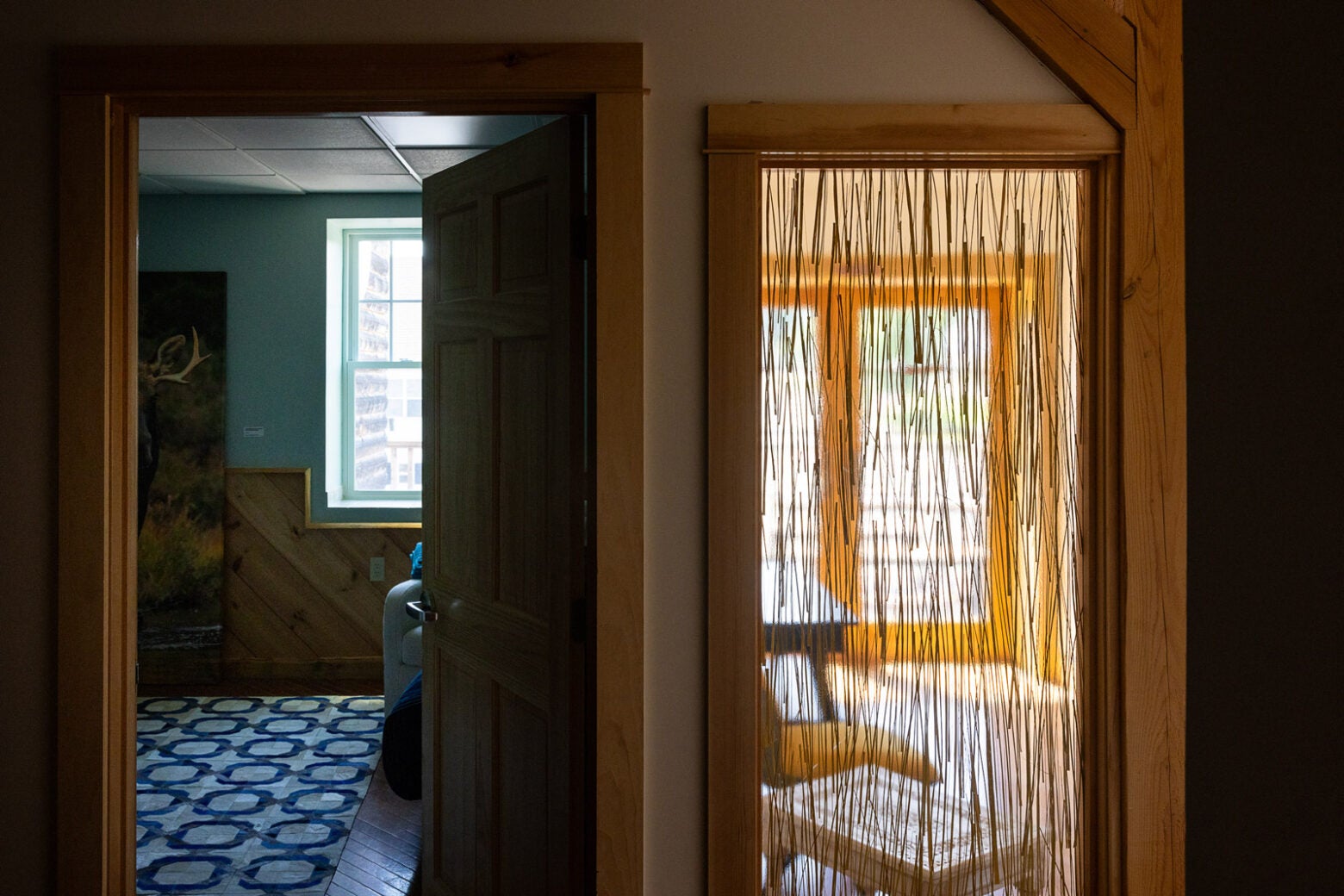
The Healing Lodge in Millinocket was designed to feel more like a home than a clinical space.
Photo: Katherine Emery

The photographs on display in the lodge are purchased from a local Millinocket photographer.
Photo: Katherine Emery
An abalone shell holds the burnt remains of a previous smudge. Next to it there’s an etched talking stick and a delicately wrapped eagle feather.
Upstairs are staff offices, private spaces for clinicians to work with clients, and a common area that can be used for gatherings or cleared for yoga and martial arts classes. Other subtle touches adorn the space: signs written in Wabanaki languages, glass paneling inlaid with sweetgrass, and baskets and dreamcatchers made by Wabanaki artists.
“We wanted to remind people of their homes,” said Sockabasin. “People all want to go home. That’s what we hear from people: They want to go home.”
WPHW chose Millinocket for the center because of the town’s proximity to Mount Katahdin.
The Penobscot County town of about 4,000 sits on the edge of Baxter State Park, a wilderness area encompassing more than 200,000 acres in Penobscot and Piscataquis counties that was established in 1931. Katahdin, or “Greatest Mountain” in Penobscot, is the tallest peak in Maine and the northernmost point of the Appalachian Trail.
It’s also sacred to the Wabanaki, or “People of the Dawnland,” whose ancestral lands encompass the mountain.
“It’s our place. It’s where we heal, has been for a long time. It’s a space that was taken from us,” Sockabasin said.

A mural of Mount Katahdin, which is sacred to the Wabanaki, in downtown Millinocket
Photo: Katherine Emery
A new 12-step program
In addition to the Healing Lodge, which opened in July 2021 and is home to an intensive outpatient program, WPHW has three recovery residences, in Bangor and Millinocket; a 10-bed detoxification center, in Bangor; and a peer-run recovery center and syringe service program, in Bangor.
While WPHW is Indigenous-focused, its programs are open to all people regardless of tribal membership.
WPHW launched its intensive outpatient program, or IOP, called Sweetgrass Road and Sage Way, in February. The program is eight hours a day, five days a week, and typically takes 12 weeks from start to finish, program director Robert Dalpee said.
It follows the same SAMHSA guidelines as most other intensive outpatient programs, but integrates Wabanaki and Indigenous healing practices.
Group meetings start with a smudge—sage to rid the space of bad energy, sweetgrass to bring in good energy, tobacco to encourage communication, and cedar for healing and protection—and may function more like a traditional talking circle than clinical group therapy.
The participants sometimes take trips to Bangor, go foraging for food with a guide, or collect sweetgrass.
“[There’s] lots of really just trying to connect people to our values, whether it’s foraging or circling or cooking,” Sockabasin said. “I mean, really what it’s about [is] how we live with each other and the earth and ourselves.”
As of early July, two people had graduated from the program, and there were three people currently enrolled. While WPHW is focused on expanding its detoxification center, Dalpee would eventually like to hire two social workers, which would allow the IOP to host up to 20 people at a time.
Dalpee and Knockwood explained that the IOP incorporates the Colorado-based Wellbriety Movement, an initiative developed in the 1990s by Don Coyhis of the Mohican Nation.
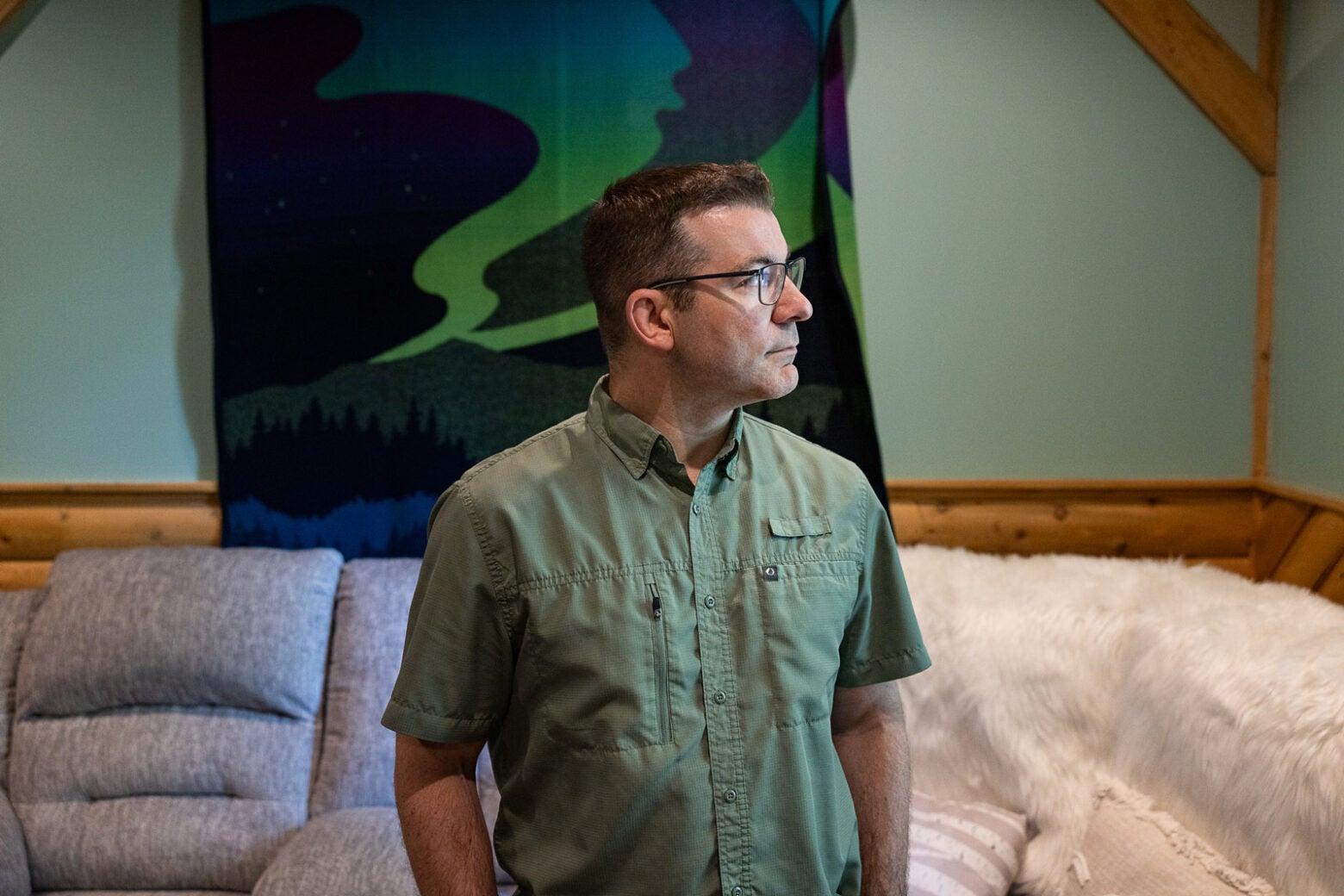
Robert Dalpee, the director of the intensive outpatient program based at the Healing Lodge in Millinocket.
Photo: Katherine Emery
Coyhis has said he spent time with Passamaquoddy elders in Maine while developing the program, and the term “Wellbriety” is a rough English translation of a Passamaquoddy word meaning an emotionally, mentally, physically, and spiritually balanced person.
Wellbriety takes aspects of other 12-step programs, such as Alcoholics Anonymous, and supplants Christian elements with Native spirituality.
“What we have tried to do within Wabanaki Public Health and Wellness, within the Wellbriety Movement, is really intentionally build spaces where our people can come and be the people they’re meant to be, to be able to freely discuss an altered sense of history without being challenged,” Knockwood said.
‘Familiarity, comfort, safety’
John, whose name The Monitor is withholding to protect his privacy, is a member of the Passamaquoddy Tribe at Motahkomikuk and grew up on the Washington County reservation. His adoptive parents split up when he was young, and he ended up in foster care. He said he developed an addiction to drugs and alcohol when he was about 10.
Prior to living at Opportunity House, WPHW’s recovery residence for men in Bangor, John, who’s now in his 40s, believes his longest period of sobriety was the 100 days spent in a rehabilitation facility in Cherokee, North Carolina, when he was 16. He went there as part of a deal to avoid jail time.
“I never had any goals during that time from childhood up until now,” John said. “Every day felt like Groundhog Day.”
John doesn’t quite remember how Knockwood contacted him. Knockwood said someone reached out to him with concerns about John’s well-being, and after a few conversations, John agreed to enter treatment.
Knockwood picked him up and brought him to MaineGeneral Health in Augusta, where he was in the medical detoxification unit for a few weeks. When John finished there, Knockwood helped him arrange a spot at Bella’s House, a residential treatment facility in Springfield. A month later, John graduated from that program, and Knockwood again picked him up and brought him to Opportunity House.
When he arrived in March of 2022, John said he felt “lost” and was resentful of the people at “The Wab,” the peer support recovery center in Bangor.
“That’s how confused I was,” John said. “But I started to learn that people actually wanted to help me. Like, genuinely. You know, usually dealing with any organization or anything like this, it kind of brings back memories of, you know, trauma of the past.”
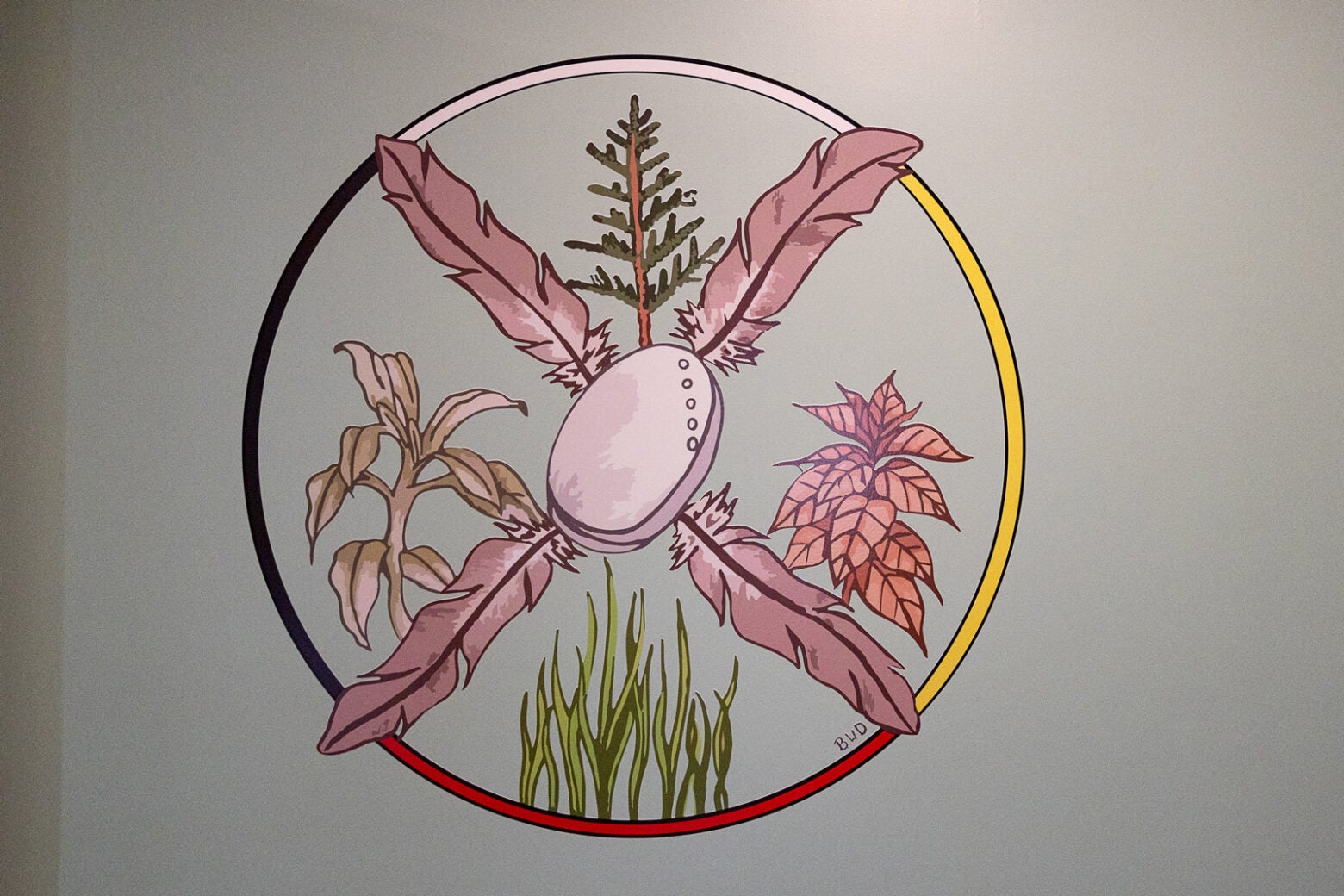
A mural representing the four medicines in Wabanaki tradition, clockwise from top: cedar, tobacco, sweetgrass and sage
Photo: Katherine Emery
John said he tried several treatment and recovery services through the years. When he exited foster care at 18, he drove back and forth from his home in Motahkomikuk to one of the few methadone clinics in the state at the time, in South Portland, every day for a couple of years.
About six years ago, he tried outpatient treatment. That lasted 10 days, he said. More recently he went to Aroostook Mental Health Center’s residential treatment facility in Limestone. But he said he had no plan when he returned home to Motahkomikuk and relapsed after just two weeks.
Opportunity House was his first sober living experience.
“What made a big difference—all the difference—was that I was amongst my people,” he said. “It’s just familiarity, comfort, safety.”
Top image: Lisa Sockabasin, co-CEO of Wabanaki Public Health and Wellness, holds an abalone shell with medicines for a smudging ceremony and an eagle feather at the Healing Lodge in Millinocket. Photo: Katherine Emery
Recovery from addiction is possible. For help, please call the free and confidential treatment referral hotline (1-800-662-HELP) or visit findtreatment.gov. Call or text the free, confidential, 24/7 Wabanaki Care Line (1-888-844-2622), a service provided by Wabanaki Public Health and Wellness. For additional information, visit 211maine.org.
Emily Bader can be reached at emily@themainemonitor.org.

